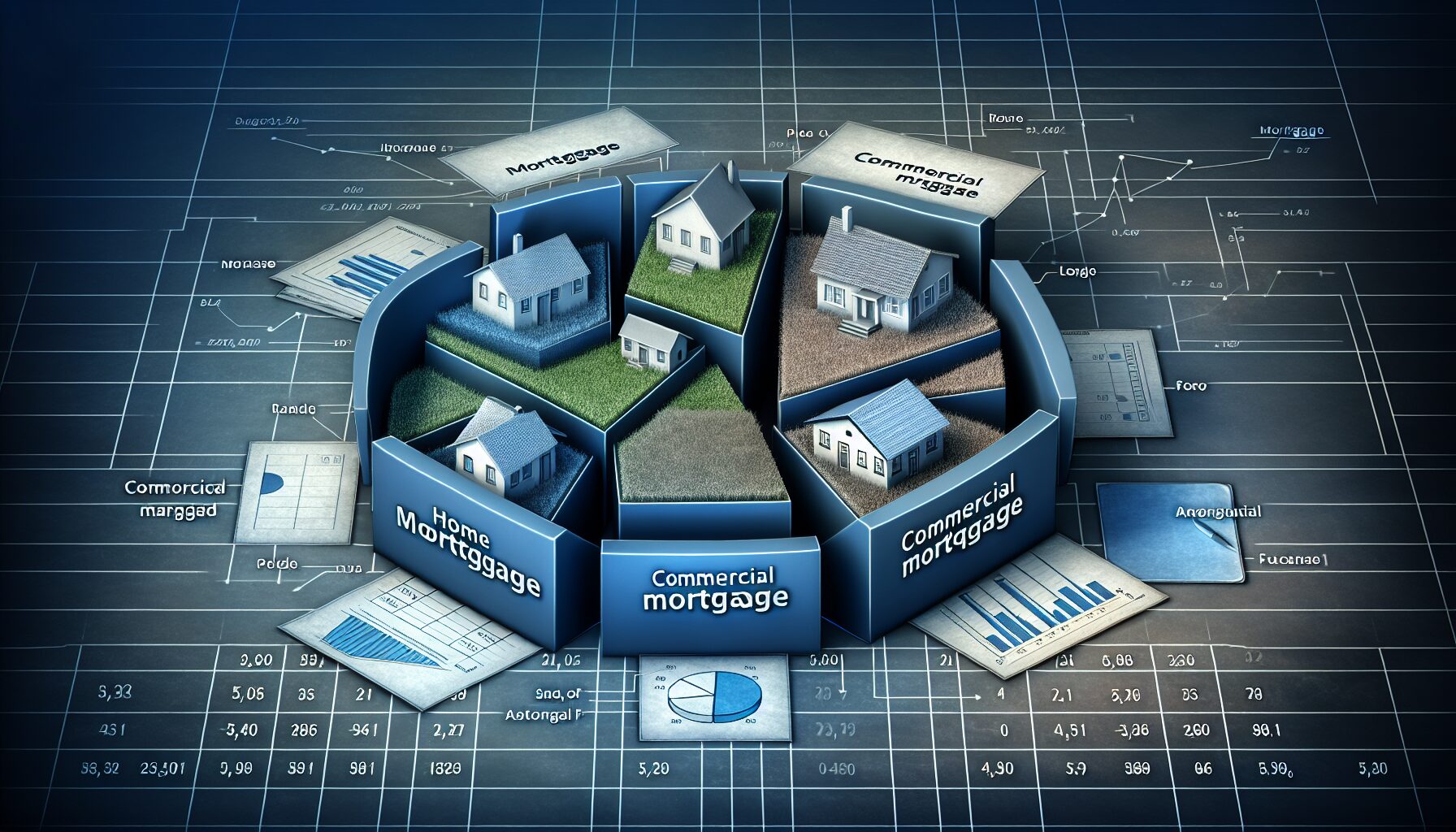
Have you ever wondered about the classification of a mortgage in accounting? Understanding the categorization of mortgages is crucial for accurate financial reporting and assessment. Whether it falls under current liabilities or long-term debt, the classification of a mortgage greatly impacts a company’s financial statements. In this article, we will shed light on the different classifications of mortgages in accounting, providing you with a clear understanding of how they are categorized and the implications they have on a company’s financial position. So let’s dive in and explore the fascinating world of mortgage classification in accounting.

Table of Contents
Definition of a Mortgage in Accounting
A mortgage is an accounting term used to describe a loan that is secured by real property. In simple terms, it is a legal agreement between a borrower and a lender, where the borrower obtains funds to purchase a property and pledges the property as collateral for the loan. The lender then has the right to take ownership of the property if the borrower fails to repay the loan according to the terms of the agreement.
Overview of a Mortgage
In accounting, a mortgage is classified as a liability on the balance sheet of the borrower. It represents the amount owed to the lender and is usually shown under long-term liabilities. The mortgage is typically structured with regular payments over a specified period of time, which includes both principal and interest components. These payments are accounted for as both a reduction of the liability and an expense for the borrower.
Accounting Treatment of a Mortgage
When a mortgage is obtained, it is initially recorded on the balance sheet as a liability. The amount of the mortgage is classified based on its repayment terms and the time frame in which it is expected to be paid off. Different classifications are used to categorize mortgages, which include current vs. non-current, secured vs. unsecured, and operating vs. financing.
Classification of a Mortgage in Accounting
Current vs. Non-current Classification
Current and non-current classifications are used to determine the time frame in which a liability is expected to be settled. A current liability is one that is expected to be settled within the next 12 months, while a non-current liability is one that is not expected to be settled within the next 12 months.
Secured vs. Unsecured Classification
Secured and unsecured classifications refer to whether or not the mortgage is backed by collateral. A secured mortgage is one that is backed by a specific property, which means that if the borrower defaults on the loan, the lender has the right to take ownership of the property. On the other hand, an unsecured mortgage is not backed by any collateral.
Operating vs. Financing Classification
Operating and financing classifications are used to distinguish between liabilities that are incurred as part of the borrower’s normal operations and those that are incurred for the purpose of financing. Operating liabilities are typically related to day-to-day business activities, while financing liabilities are incurred to fund long-term investments or acquisitions.

Current vs. Non-current Classification
Definition of Current and Non-current Assets
Before understanding the classification of a mortgage as current or non-current, it is important to understand the concept of current and non-current assets. Current assets are those that are expected to be converted into cash or used up within the next 12 months, while non-current assets are those that are expected to be held for longer than 12 months.
Determining the Classification of a Mortgage
To determine whether a mortgage should be classified as current or non-current, the borrower must analyze the repayment terms and consider the expected timeframe for settlement. If the mortgage has regular payments that are due to be paid off within the next 12 months, it is classified as a current liability. However, if the payments extend beyond the next 12 months, it is classified as a non-current liability.
For example, if you have a mortgage with monthly payments of $1,000 and the remaining term is 8 years, the mortgage would be classified as a non-current liability since it extends beyond the next 12 months.
Secured vs. Unsecured Classification
Definition of Secured and Unsecured Debts
The classification of a mortgage as secured or unsecured depends on whether or not it is backed by collateral. A secured debt is one that is backed by an asset, such as real estate, which provides the lender with a means of recouping their investment if the borrower defaults on the loan. An unsecured debt, on the other hand, is not backed by any specific asset.
Implications for Mortgage Classification
If a mortgage is secured, it is classified as a secured liability on the balance sheet. This means that the property being financed is used as collateral for the loan. On the other hand, if a mortgage is unsecured, it is classified as an unsecured liability. The classification of a mortgage as secured or unsecured can have significant implications for the borrower, as it affects the terms and interest rates offered by lenders.

Operating vs. Financing Classification
Distinguishing between Operating and Financing Liabilities
The classification of a mortgage as operating or financing depends on the purpose for which the liability is incurred. Operating liabilities are incurred as part of the borrower’s day-to-day operations and are typically short-term in nature. Financing liabilities, on the other hand, are incurred to fund long-term investments or acquisitions and are typically long-term in nature.
Impact on Mortgage Classification
If a mortgage is obtained to finance the acquisition of property for ongoing operations, it is classified as an operating liability. This is the case when the property being financed is used directly in the borrower’s day-to-day operations. However, if a mortgage is obtained for the purpose of financing a long-term investment or acquisition, it is classified as a financing liability.
For example, if you are a real estate developer and you obtain a mortgage to finance the acquisition of a property that you plan to develop and sell, the mortgage would be classified as an operating liability. However, if you obtain a mortgage to finance the acquisition of a property that you plan to hold as an investment, the mortgage would be classified as a financing liability.
Other Factors Affecting Mortgage Classification
Maturity Date
The maturity date of a mortgage refers to the date on which the loan is due to be fully repaid. The maturity date can affect the classification of a mortgage as current or non-current. If the maturity date falls within the next 12 months, the mortgage is classified as a current liability. If it falls beyond the next 12 months, it is classified as a non-current liability.
Terms and Conditions
The terms and conditions of a mortgage can also impact its classification. For example, if a mortgage has a balloon payment at the end of the term, where the remaining balance is due in a lump sum, it could affect the classification of the mortgage as current or non-current. If the balloon payment is due within the next 12 months, the mortgage would be classified as a current liability.
Intent of the Borrower
Lastly, the intent of the borrower can also affect the classification of a mortgage. If the borrower intends to refinance a mortgage before the end of the term, it may be classified as a current liability, even if the maturity date is beyond the next 12 months. This is because the borrower has the intention to settle the mortgage within the next 12 months by refinancing it.

Disclosure and Presentation Requirements
Financial Statements
Accounting standards typically require the disclosure of mortgage liabilities on the balance sheet of the borrower. The mortgage is presented as a separate line item under either current or non-current liabilities, depending on its classification. The amount of the mortgage and any related interest expense are also disclosed on the income statement.
Footnotes and Disclosures
In addition to the presentation on the financial statements, it is common for footnotes and disclosures to be provided to provide further information about the mortgage. This may include details about the interest rate, repayment terms, collateral, and any covenants or restrictions associated with the mortgage. These disclosures are important for stakeholders to fully understand the nature and risk associated with the mortgage.
Impact on Financial Analysis
Liquidity Assessment
The classification of a mortgage as current or non-current has implications for the borrower’s liquidity assessment. Current liabilities are expected to be settled within the next 12 months, so having a significant amount of current liabilities, including mortgages, may indicate a potential liquidity issue. On the other hand, non-current liabilities are not expected to be settled within the next 12 months and may have less impact on short-term liquidity.
Risk Evaluation
The classification of a mortgage as secured or unsecured can also impact the risk evaluation of the mortgage. A secured mortgage provides the lender with an added level of security, as they have the right to take ownership of the underlying property if the borrower defaults. An unsecured mortgage, however, may be seen as higher risk, as there is no specific collateral to protect the lender in the event of default.
Debt-to-Equity Ratio
The classification of a mortgage as either operating or financing can affect the debt-to-equity ratio, which is a measure of a company’s financial leverage. Operating liabilities are typically excluded from the calculation of the debt-to-equity ratio, as they are considered part of the normal operations of the business. Financing liabilities, on the other hand, are included in the calculation as they represent funds borrowed to finance long-term investments.

Importance of Accurate Mortgage Classification
Compliance with Accounting Standards
Accurate mortgage classification is important to ensure compliance with accounting standards. These standards provide guidelines on how mortgages should be classified and presented in financial statements. Failure to comply with these standards can result in financial statements that are not reflective of the true financial position and performance of the borrower.
Transparency and Stakeholder Confidence
Accurate mortgage classification also enhances transparency and stakeholder confidence. Stakeholders, such as investors and lenders, rely on accurate financial reporting to make informed decisions about their investments. By accurately classifying and presenting mortgages, borrowers can provide stakeholders with a clear and reliable picture of their financial position and performance.
Conclusion
In conclusion, the classification of a mortgage in accounting involves determining its current vs. non-current, secured vs. unsecured, and operating vs. financing status. This classification is important for the accurate presentation of the mortgage on the borrower’s financial statements and has implications for financial analysis, risk evaluation, and compliance with accounting standards. By understanding the classification of a mortgage and accurately applying it, borrowers can provide transparency and instill confidence in their stakeholders.







